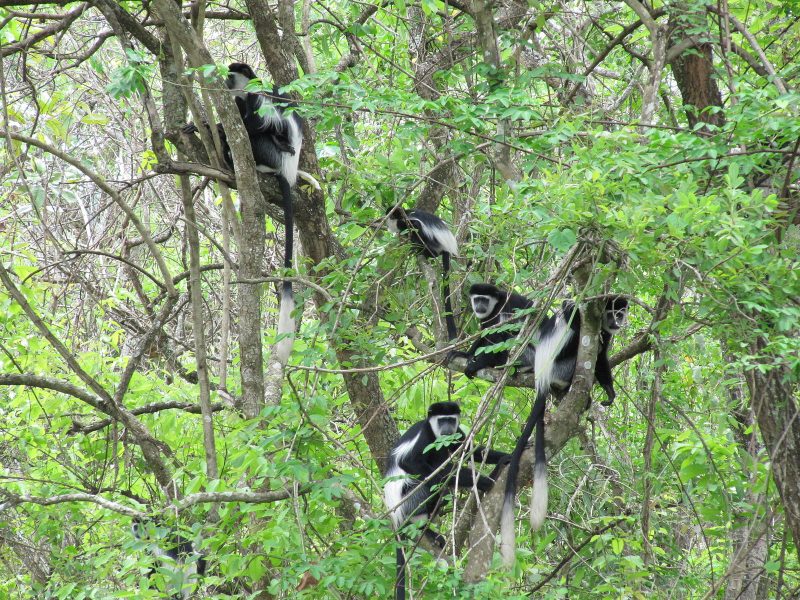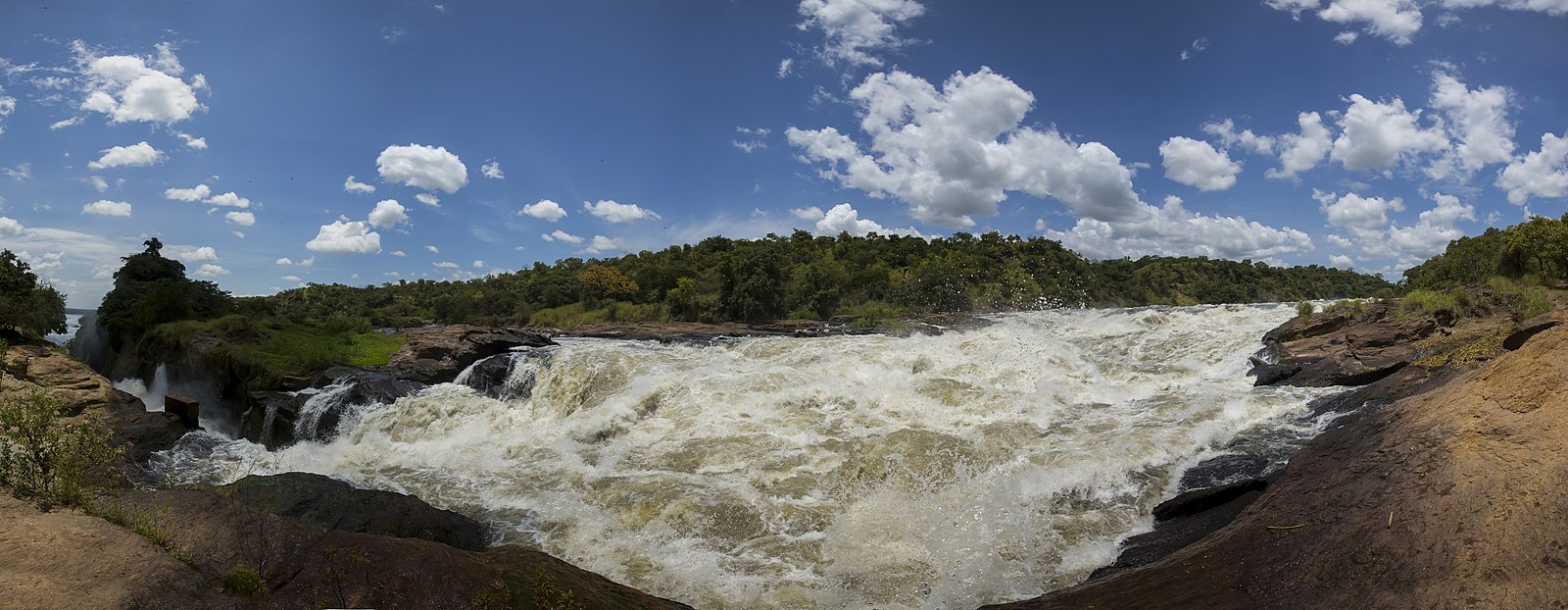Also known as the Kabalega National Park, the Murchison Falls National Park is popularly known for having the world’s most powerful waterfall that emits large volumes of water about 300 cubic meters per second or 11,000 ft³/s at a very powerful pressure that cause the surrounding to tremble. The park was first gazetted in 1927 and today is the largest park in Uganda covering an area of 3840 sq km / 1483 sq miles.
The park straddles the Ugandan districts of Buliisa, Nwoya, Kiryandongo, and Masindi. The driving distance from Masindi, the nearest large town, to the Kibanda area of the national park is about 72 kilometres (45 mi). This area is about 283 kilometres (176 mi), by road, north-west of Kampala, the capital and largest city of Uganda. The coordinates of the park near the Kibanda area are 02°11’15.0″N, 31°46’53.0″E (Latitude: 2.187499; Longitude: 31.781400)
The explorers John Speke and James Grant were the first Europeans to visit the present day MFCA in 1862. It was more thoroughly explored by Samuel and Florence Baker in 1863–4. Baker named the falls Murchison Falls after the geologist Roderick Murchison, then the president of the Royal Geographical Society.
Between 1907 and 1912, the inhabitants of an area of about 13,000 square kilometres (5,000 sq mi) were evacuated due to sleeping sickness spread by tse-tse flies. In 1910, the Bunyoro Game Reserve was created south of the River Nile. That area roughly corresponds to the part of the MFNP that is in the districts of Buliisa, Masindi, and Kiryandongo. In 1928, the boundaries were extended north of the river into the modern-day Nwoya District.
In 1952, the British administration established the National Parks Act of Uganda. The area described above became Murchison Falls National Park
Activities done in Murchison Falls National Park
Hot Air Ballon
Enjoy the unique experience of flying in a hot air balloon with one of the following options only available at Murchison Falls National Park:
Sunrise/Post sunrise hot air balloon safari with/without bush breakfastSunset hot air balloon safariShort rides for large groups and students
Game drives
In Murchison Falls National Park game viewing can be enjoyed while on a game drive in several designated game drive areas. The main areas are the Delta where there are great chances of seeing the Lions in wait for prey as they go to drink, the Buligi Peninsula and the southern sector famoulsy known as the heart of Murchison.
Buligi Peninsula
The park’s prime game viewing area lies on the Buligi Peninsula, a triangle of grassland bounded by the Victoria Nile entering Lake Albert, and the Albert Nile flowing out if it. Expect to see elephant, buffalo, antelopes and giraffe and keep your fingers crossed for lion and leopard. The game track network converges at Delta Point where the Nile flows north out of Lake Albert; this is a convenient place to stop for refreshments and view waterbirds offshore and distant hippos.
Visitors can also take to the air to explore the plains north and west of Paraa in a hot air balloon. Contact the Jobihani Dream Balloons office at Paraa Safari Lodge
Heart of Murchison
While much of the southern part of MFNP is covered by bush and forest, a delightful tract of savanna rolls down to the river from the Rabongo road in the very centre of the park. Vehicle tracks have recently been opened in this area, which thanks to substantial herds of Uganda kob, is becoming known as a prime location for lions. The ‘Heart of Murchison’ lies 20km east of the Masindi-Paraa road.
In January 2016 15 giraffes were trans- located to this area and now it is possible to spot these giants on the Honey Moon track
Birding
Both the game drives and the launch trips offer an opportunity for one to come across distinct birdlife, including savannah forest birds, water birds and Albertine Rift endemics. The park’s main birding attraction is the Shoebill, best sighted in the dry season from January-March. The commonest species found in the plains include the Marabou Stork, Abyssinian Ground Hornbill, Secretary Birds, Black-bellied Bustards, Open-billed Storks and Widow Bird.
Closer to the river where there are more thickets and woodlands, the commonest bird varieties include the Swallow-tailed and Red-throated Bee-eaters – particularly in the Nyamusika Cliffs; Woodland, Pied, Giant and Malachite Kingfishers; Francolin; Hornbills, Grey heron; Hamerkop; Shrikes; Flycatchers; Cuckoos; Woodpeckers; Crombecs and Warblers. The riverbanks are also home to ducks, geese, stilts and plovers.
The park’s main birding attraction is the Shoebill, best sighted in the dry season from January-March
Launch Boat Trip
The launch trip upstream from Paraa presents an astonishing display of wildlife and culminates with the memorable frontal view of the fall. The launch departs at 9am and 2pm daily and takes three hours. Recommended for birders is a morning cruise downstream to the Nile-Lake Albert Delta, providing the best chance in Africa of sighting the elusive Shoebill. This four- to five-hour return voyage also takes in a variety of other wildlife, including hippos, elephants and many birds.
A tranquil sundowner boat cruise at 5.30pm offers the classic view of an equatorial sunset reflected on the river.
Fishing
Fishing in Murchison falls National Park is quite rewarding for the avid angler. There are great opportunities to land a large Nile Perch “mputa” or Cat-fish “semutundu”. Other fish include Tiger fish, Electric cat-fish, Tilapia, “Ngara” (Genus Alestes). The record largest Nile Perch was 113 Kgs landed at at the water gauge opposite the crocodile pool, and the largest cat-fish was 45 Kgs landed near the Nyamusika Cliffs
Experienced UWA Guides are available to lead you to the best fishing spots, however, Wild frontiers operates a fishing concession at Murchison falls National Park and they can be contacted privately. A fishing permit is required and currently (March 2019) is at $50 per day or $150 for four days. Park entrance fees are paid separately details are on the UWA Tariff.
World famous anglers including Jeremy Wade (River Monsters presenter), The late John Dennis Wilson MBE (RIP) (1943 – 13 November 2018) a former UK TV presenter and Zeb Hogan of Monster Fish National Geographic TV have been on the Nile in Murchison looking for that big one!

Hiking and Nature walks
The vast landscapes and varied scenery of Murchison Falls National Park and the surrounding Conservation Area can be explored on foot. Trails through Kaniyo Pabidi and Rabongo Forests provide sightings of many primates and birds, while around the Nile-Lake Albert Delta, two- to four-hour guided swamp walks offer possible sightings of the Shoebill when the water level is low. After an afternoon boating upriver, you can also hike 45 minutes through woodland to the top of Murchison Falls for a completely different experience of this magnificent waterfall.
This is an experience that brings all the senses into play: watch waves of white water tumble hypnotically through this six-meter chasm, listen to the roar, taste the spray on your face and feel the rock shake beneath your feet. Sheer sensory overload! If you don’t fancy the trek to the top, stop off at the north bank during your game drive, and walk down a set of steps to stand within meters of the rapids.
Birders and nature lovers can enjoy short treks starting from Sambiya River Lodge or Mubako Junction, both on the south bank, or a walk along the north bank from Paraa, passing the Emmy River. All walks last from one and a half to two hours.
Cultural Encounters
Energetic dancers from Mubako perform around lodge campfires, making for a magical African experience at dusk. Boomu Women’s Group offers accommodation, a craft shop and village tours, revealing the realities of life in this rural community.
Mubako Cultural Campfire Performances
The remote community of Mubako is located beside the sprawling savannah of Murchison Falls National Park. The village is a cluster of traditional thatched huts around a clearing, where villagers gather to escape the midday sun under the shade of a large tree.
Mubako’s small craft shop sells carved wooden sculptures and handwoven items made by community members. At dusk, the local cultural groups perform vibrant songs and dances around the campfires of local lodges, accompanied by the beautiful sound of the adungu. Originating from this region, this instrument is made of cowhide and twine, and the harmonies of the various-sized adungus against the backdrop of a Nile sunset are magical.
There are few economic opportunities in this region and the climate makes farming hard, but with the money generated through tourism, the community can buy produce from local markets, pay school fees and support a nursery for 90 children.


Comment (0)